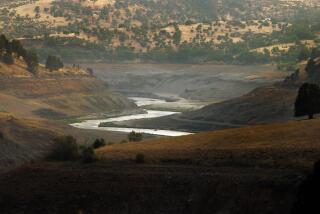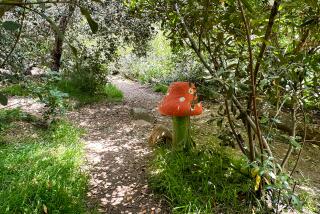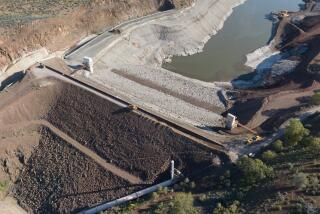Pasadena halts Devil’s Gate Dam dirt removal to save toads
- Share via
The removal of 25,000 cubic yards of sediment from the basin behind Devil’s Gate Dam in Pasadena has been put on hold until August in order to prevent the destruction of a habitat for toads.
Work was set to begin last week, but Pasadena officials decided to postpone the job pending further environmental review after Hahamongna Watershed Park users complained that Johnson Field, where the dirt was to be temporarily stored, was home to a large number of toads that would be smothered underneath the piles of dirt.
Johnson Field, an unused Pasadena groundwater restoration basin, was selected for use as an alternative to trucking the dirt past the southern end of the JPL parking lot, through Altadena, then east along the 210 Freeway to a fill area in Irwindale.
The city will reconsider the issue in August after standing water in Johnson Field dries out, and the amphibians, members of common western toad species, leave for other grounds, according to Pasadena city engineer Dan Rix.
“We’re still working with Pasadena to use the field,” said Chris Stone, assistant deputy director of the Department of Public Works’ Water Resources Division.
“There was a concern with toads that use the area early in the summertime, but our biologists are telling us the toads move out of the area once it dries out, and that should be around the end of the month,” Stone said. “We’re hoping that at that point the city gives us a permit.”
County officials say sediment must be removed from around the dam face to prevent valves and other dam works from possibly clogging up during winter rains.
“It’s going to be tight [timing], but we shouldn’t have a problem if we can get started in the next three or four weeks,” Stone said.
The project is the initial step in a larger plan to ultimately remove roughly 1.5 million cubic yards of mud and debris, most of it deposited after the August 2009 Station Fire.
According to Stone, that second phase of the project could require 300 to 400 truck trips per day out of the basin for several months — a troubling prospect for officials in La Cañada Flintridge and Altadena that prompted county supervisors to order environmental studies that could take up to two years to complete.
Also at issue is the destruction of about 50 acres of wooded area that has grown on mud deposits behind the dam, creating a habitat for wildlife and a popular spot for local hikers, dog walkers and equestrians.
The estimated cost of this summer’s interim sediment removal is $1.6 million. The larger project could carry a price tag of up to $40 million, Stone said.
Under Pasadena’s Hahamongna Watershed Park Master Plan, Johnson Field — once commandeered by city employees as a makeshift softball field — will ultimately return to use as a water-percolation field or be left as natural park space.
More to Read
Sign up for Essential California
The most important California stories and recommendations in your inbox every morning.
You may occasionally receive promotional content from the Los Angeles Times.










